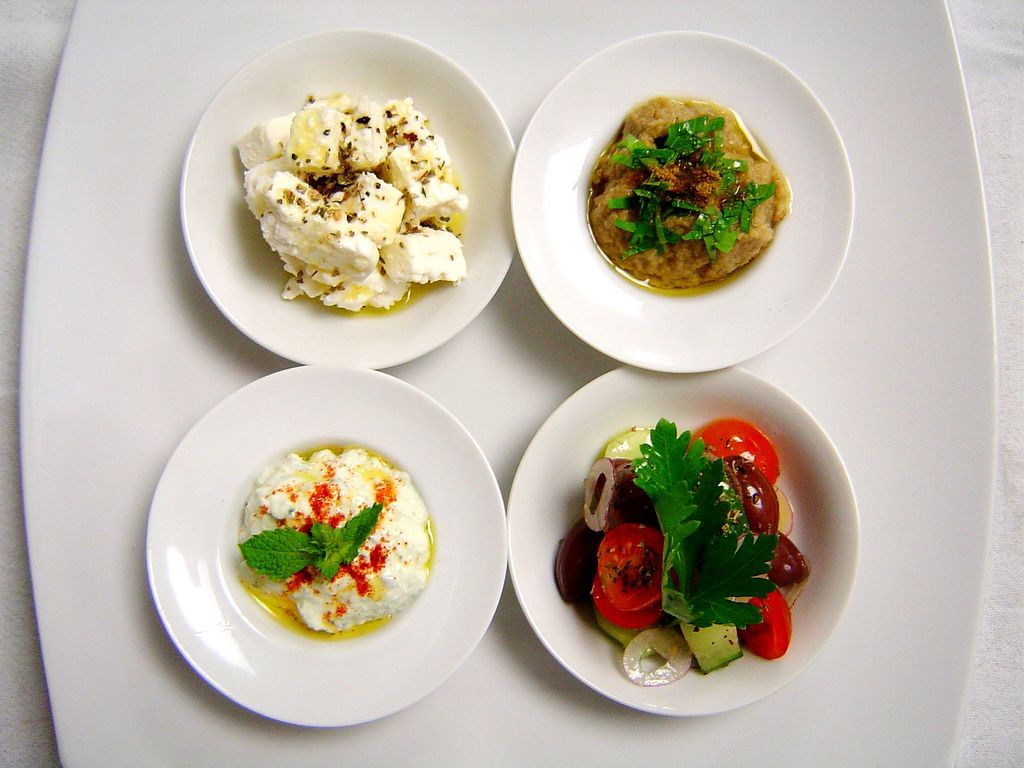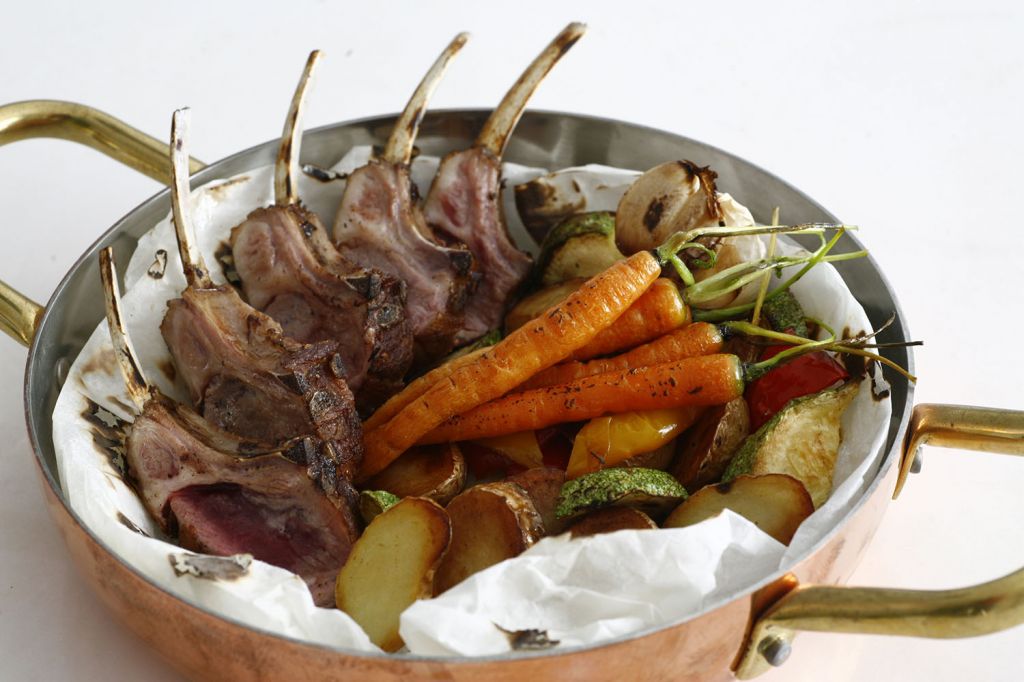Greek cuisine is one of the oldest culinary traditions in the world and one of the most representative examples of Mediterranean cuisine. Among the most common ingredients we find olive oil, lamb meat, fish and a great variety of vegetables such as aubergines, tomatoes, peppers and courgettes. If you are going to spend a holiday in Greece and in the Greek islands and you are interested in learning about the best dishes of Greek cuisine continue to read our article.
Mezedes (Appetizers)

Choriatiki salata [Χωριάτικη σαλάτα] – Although the Greek word literally means salad of the village, it is famous all over the world as a Greek salad, it is a fresh dish with tomatoes, cucumbers, green peppers, onions, olives, dominated by feta (sometimes it is crumbled with the other ingredients), oregano and olive oil. It is one of the simplest and lightest foods that can be found on Greek tables.
Dakos [Δάκος] – Hard barley bread with crumbled feta (rarely cream), diced tomatoes, oregano and olive oil. Very similar to friselle (or freselle) very widespread in southern Italy. They are traditional of Crete.
Dolmades [Ντολμάδες] – It is one of the most widespread dishes in the Middle East, among the peoples who have been or have been dominated by the Ottoman Empire. The term dolmas (singular of dolmades) comes from Turkish and means stuffing. In fact, they are vine rolls stuffed with rice, onion, mint, dill and other spices. Minced meat may also be present (me kima [με κιμά]). If cabbage leaves are used instead of grapevine, they are called lahanodolmades [λαχανοντολμάδες]. They are often served in the avgolemono. Dolmadakia [ντολμαδάκια] means small dolmades.
Keftedes [Κεφτέδες] – They are fried meat with cheese, mint and various spices although often the appearance and texture are more similar to pancakes. When the main ingredient is different from meat, it is placed in the name: for example, aubergines (melitzano [μελιτσανο]), courgettes (kolokitho [κολοκυθo]), chicken (koto [koτo]), potatoes (patates [πατατες]), cheese (shoot [τυρo]), leeks (praso [πρασo]), tomato (tamed [ντοματο] or psefto [ψευτο]).
Saganaki [Σαγανάκι] – Although it is one of the best-known Greek specialties in the world, many believe it is simply fried cheese. Saganaki is the diminutive of sagani, a word derived from the Turkish sahani, a particular copper pan used for frying. When only saganaki is indicated in the menu, it is cheese (tyri saganaki [τυρί σαγανάκι]) breaded with the addition, after cooking, of ouzo, honey and / or lemon juice. Feta cheese is not the most used cheese: often, in fact, it is highlighted by indicating feta saganaki. Soft cheeses are preferred but do not melt during frying: kasseri (the most widespread), graviera, kefalotyri, kefalograviera, halloumi, batzos and formaella. If another ingredient is present along with the cheese, the name is indicated: for example, garides saganaki (shrimp), midia saganaki (mussels), both described in this list.
Spanakopita [Σπανακόπιτα] – parcels of filo pastry filled with spinach, cheese (usually feta), onion and various spices. It has the shape of a piece of cake if prepared in large trays or in the shape of a spiral (strifti [στριφτή]) if done in single portions.
Taramosalata [Tαραμοσαλάτα] – Pink cream made with tarama [tαραμά], fish roe (cod, carp or similar) preserved in brine, mixed with onions, lemon juice, garlic and olive oil. It can also be prepared by adding potatoes (me patates [πατάτες]). It is always topped by an olive and, sometimes, served with tomatoes, cucumbers, onions and / or fish.
Tiropita [Τυρόπιτα] – It is the most known and widespread rustic pie in Greece: filo pastry or puff pastry with cheese, almost always feta, and various spices. Kefalotiri or kasseri can also be used. Proposed in slices of cake or triangular bundles, often small and, therefore, called tiropitakia [τυροπιτάκια].
Tzatziki [Tζατζίκι] – The most famous Greek sauce in the world. It is used in all ways: as an appetizer, as a side dish to main dishes or as an ingredient of other dishes including gyros pita. It is made with yogurt, cucumbers, garlic, dill, salt and olive oil. Sometimes a little vinegar is added.
Merides (Main courses)

Garides Saganaki [Γαρίδες Σαγανάκι] – Fried prawns in tomato sauce with feta cheese and other grated cheese (often kefalograviera), peppers, onion, garlic, parsley, ouzo and various spices. It is one of the most famous seafood dishes of Greek cuisine. They are also called garides Mikrolimano [γαρίδες Μικρολίμανο] or garides Tourkolimano [γαρίδες Τουρκολίμανο]), since they are one of the most common dishes in the port of Piraeus bearing this name.
Gemista [Γεμιστά] – Tomatoes and peppers stuffed with rice, tomato sauce, onions, spices and various aromas. Minced meat may also be present (me kima [με κιμά]). In Crete they usually replace the rice with bulgur (me pliguri [με πλιγούρι]), a wheat similar to couscous. In general, gemista means stuffing and can indicate different types of vegetables: for example, when mushrooms are used they are called manista gemista [μανιτάρια γεμιστά].
Giouvetsi [Γιουβέτσι] – meat stew in tomato sauce cooked in a pan (gastra [γάστρα]) with rizoni [ριζόνι] (risoni, a type of pasta in the shape of rice also widespread in Italy), onions, various spices and mizithra grated. Other versions include kritharaki [κριθαράκι] (barley), hilopites [χυλόπιτες] (square-shaped pasty) or other types of pasta instead of rice. The most used meat is lamb (arni [αρνί]), but it is also prepared with chicken (kotopoulo [kοτόπουλο]) or with beef (moschari [μοσχάρι]). You can also find the sea version, with shrimps (garides [γαρίδες]).
Gyros Pita [Γύρος πίτα] – The pita is a round and flattened bread, but thicker, softer and more compact than the piadina romagnola or that used for kebab. It is baked in the oven without any seasoning and then heated on a plate soaked in oil. The meat is pork also there are variations with chicken (chicken pita) and with meat skewers (souvlaki pita). It is stuffed with tomato, chips and onions and tzatziki sauce. Sometimes a little paprika is added. It is also served (gyros plate), with the same side dish and in abundant portion. It is a complete food that can act as a whole meal.
Kleftiko [Κλέφτικο] – Indicates a type of cooking of the meat (usually lamb, but also pork or beef), closed in tin or baking paper (ladokolla [λαδόκολλα]) along with peppers, cheese (kefalotiri or other grating), potatoes , garlic, onions, oregano, mint, bay leaf, mustard and pepper. With this technique the meat remains soft and absorbs all the aromas of the other ingredients.
Moussaka [Μουσακάς] – It is the most famous Greek food in the world: it is impossible not to find it in a menu of a Greek tourist tavern. The aspect is very similar to parmigiana: aubergines, potatoes, minced meat are put in the oven and garnished with a thick layer of béchamel au gratin. It is also often found in a vegetarian version.
Pastitsio [Παστίτσιο] – The Italian mess as they do in Greece: baked pasta with minced meat, cheese and béchamel sauce. Macaroni or double spaghetti can be used.
Souvlaki [Σουβλάκι] – Skewer stuffed in different ways. The most common is meat, alternating with some grilled vegetables. The meat can be lamb, pork and chicken. In the areas of the sea and on the islands you can also find fish. It is served or put in a pita, always with tzatziki, fries and other side dishes. In many restaurants and fast foods they are also called kalamaki [καλαμάκι].
Glyka (Cakes)Bougatsa [Μπουγάτσα] – Fillo pastry cake filled with custard cream used mainly for breakfast. The best are those of Thessaloniki, a city from which it seems to come, and of Crete: to experience that of Chania, where it takes the name bougatsa Chanion [Χανιών]. There is also a savory version, prepared with minced meat (me kima [με κιμά]) or cheese (me tiri [με tυρί]) mizithra.
Baklava [Μπακλαβά] – It is one of the most famous and widespread desserts in the Middle East area. The origin is probably Turkish. It is made of filo pastry stuffed with chopped nuts (almonds, walnuts and / or pistachios), cinnamon, butter and honey syrup.
Ekmek Kataifi [Εκμέκ Kαταΐφι] – Composed of three layers: kataifi paste soaked in syrup, custard and cream. It is often covered with ice cream.
Galaktoboureko [Γαλακτομπούρεκο] – Sweets made of layers of filo pastry filled with custard (flavored with lemon and / or orange juice) and covered with citrus syrup.
Giaourti [Γιαούρτι] – The Greek yogurt is much denser than the Italian one, in fact it looks like a spreadable cheese. This is due to the fact that the acid whey is filtered during its production, completely identical to that of normal yoghurt. It can be eaten alone (sketo [σκετο]) or served with honey and peanuts (me meli kai karydia [με μέλι και καρύδια]).
Kataifi [Kαταΐφι] – A classic of the Greek confectionery tradition, though widespread throughout the Middle Eastern area. They are cakes of kataifi pasta (mixture of water, flour, salt and oil in the form of spaghetti with a crunchy consistency) stuffed with nuts, almonds and honey, and steeped with sugar syrup and butter.
Kourabiedes [Κουραμπιέδες] – They are biscuits that are never missing in the houses during the Christmas period, even if they are sold all year round. They are round or crescent shaped. They have hard exterior and covered with powdered sugar; the interior is friable. They are characterized by an intense taste of almonds and butter with a citrus aroma.
Loukoumades [Λουκουμάδες] – Fried balls (rarely donuts) soaked in sugar syrup, covered with honey. They are also covered with cinnamon, sesame and / or chocolate.
Pasteli [Παστέλι] – Sweet bars made with honey and sesame. It is one of the most common snacks in Greece and one of the oldest, so much that Homer tells of some very similar desserts. It is found in sachets at the supermarket or in bars. They can also be found with other ingredients such as nuts, peanuts and almonds.
If you wish to spend your holidays on Paros, discover our exclusive collection of villas in Paros and all the services dedicated to our customers.


